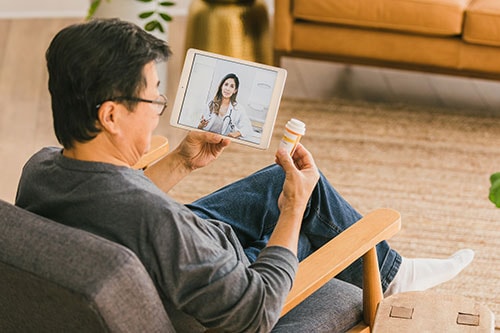Increasing Access to Diabetes Education
Ensuring that all people with diabetes have the knowledge and support they need to manage the condition

Telehealth is an effective way to address some barriers to DSMES services.
Diabetes self-management education and support (DSMES) services empower people with diabetes to reach their daily and lifetime goals for living well with diabetes. DSMES can also help lower health care costs by reducing hospitalizations, hospital readmissions, and emergency room visits for people with diabetes.
DSMES services are especially critical for communities with limited resources and populations that have higher rates of diabetes and higher risk of complications.
Although the benefits of DSMES are well known, less than 5% of Medicare beneficiaries and 6.8% of people with private insurance use these services in their first year of diagnosis. To reach more people, CDC is working to identify and remove barriers, including barriers to access and participation.
Reaching Populations and Communities With Limited Access
DSMES Best Practices
CDC developed a practice-based guide pdf icon[PDF – 6.5 MB] to share lessons learned from DSMES programs that have been successful in their efforts to reach populations that have barriers to health care access. These populations include:
- Racial and ethnic minority groups.
- People with lower incomes.
- People living in rural areas.
The guide provides tips and tools that can be used in a variety of settings and for all populations with diabetes-related disparities. It is designed to complement the DSMES Toolkit, which provides resources and tools for developing, promoting, implementing, and sustaining DSMES services.
Pharmacy-Based DSMES
In many communities, pharmacists are among the most accessible health care professionals. People with diabetes see a pharmacist seven times more often than they see a primary care doctor.
Pharmacists are an important part of a person’s health care team. They can provide DSMES directly in a pharmacy, clinic, hospital, or long-term care facility. CDC supports and promotes pharmacy-based DSMES as a proven way to expand access to reach populations that have barriers to health care.
Community Health Workers
A community health worker (CHW) is a frontline public health worker who is a trusted member of the community they serve. Because CHWs understand the cultures that make up their community, they can help residents who have less access to health care find resources such as DSMES. CHWs can accomplish this through outreach, community education, informal counseling, social support, and advocacy.
CHWs can also play a key role in addressing the social conditions that affect people’s overall health. They provide a range of support, from helping people meet their basic physical needs to working in the community to address the underlying causes and consequences of poor health.
CDC actively supports CHWs to help them deliver DSMES services in communities across the United States.
Telehealth
Technological advances, increased web connectivity, and innovative funding have made telehealth an effective way to address some barriers to DSMES services. Telehealth is promising because:
- It can reach more participants than traditional in-person programs. Telehealth technologies are less restricted by distance and time barriers, making them more accessible for rural and underserved populations.
- Many health care providers offer DSMES services through telehealth.
- Many potential participants have access to the Internet or devices needed to use telehealth.
CDC created a Guide for Using Telehealth Technologies pdf icon[PDF – 933 KB] for organizations that want to offer DSMES services through telehealth. It describes practical steps for getting started and lists specific considerations for each telehealth technology.